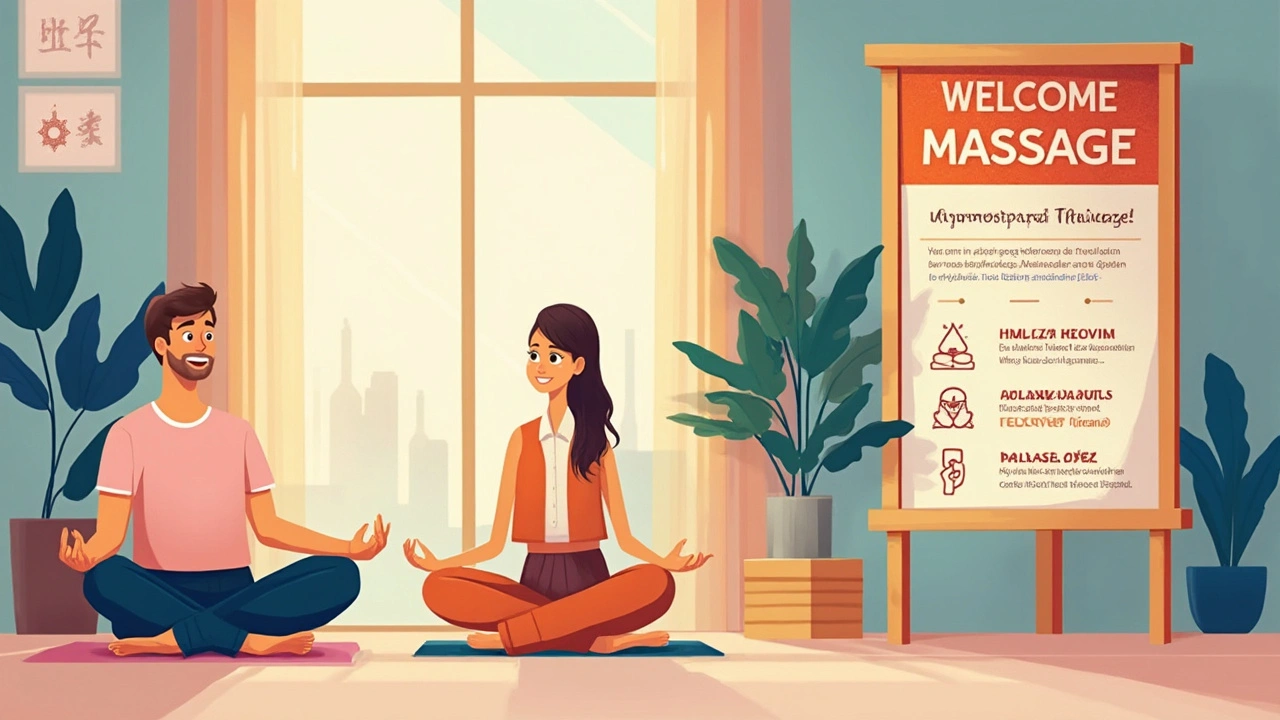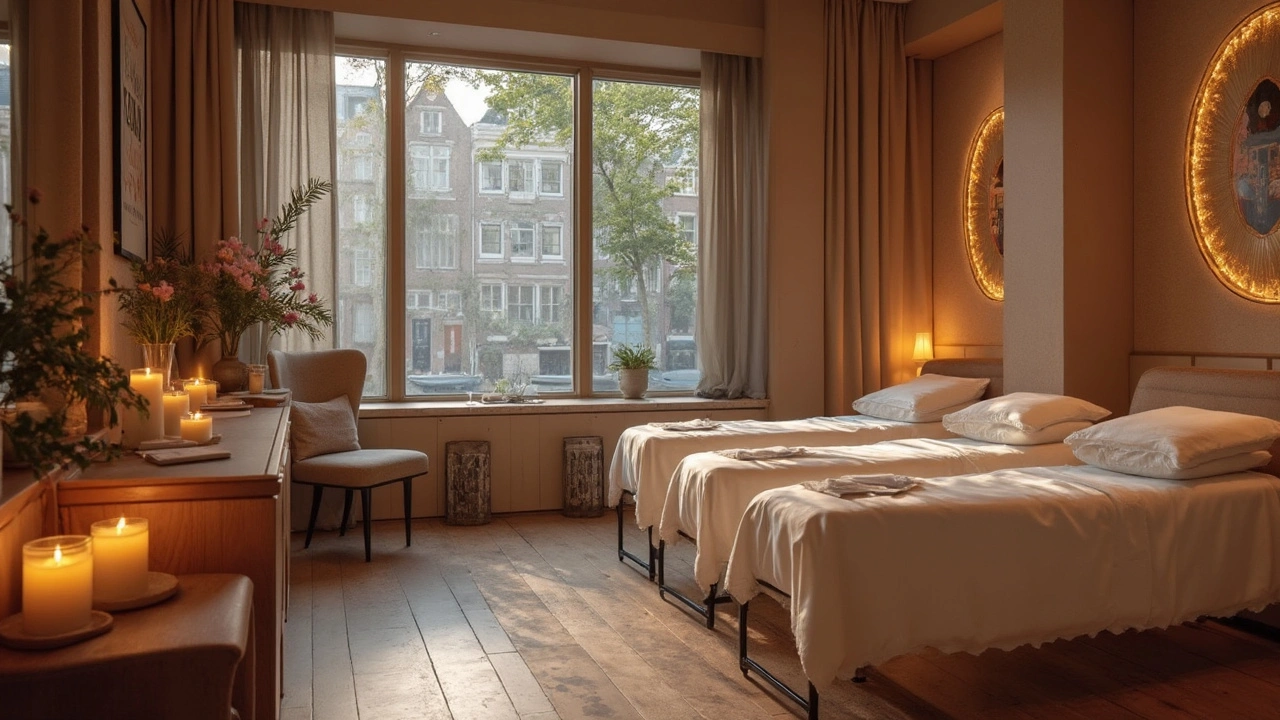Thai Massage: Embrace Serenity with Proven Relaxation Techniques

Ever feel like your body is just screaming for a reset? Thai massage is like hitting the refresh button when stress, stiffness, or endless screens start to wear you down. Forget fancy treatments that sound good but leave you wondering if it worked. Thai massage uses real, time-tested techniques that target tension and help your body relax, stretch, and recover—no yoga experience needed.
This isn’t just another spa trend. Developed over 2,500 years ago, Thai massage takes a full-body approach. Picture gentle stretches, rhythmic pressing, and slow rocking that actually help loosen knots and ease your mind. It’s like yoga, but someone else does all the work. You stay comfortable—fully clothed, no slippery oils, and zero awkwardness.
People often leave their first session thinking, “Wow, I didn’t realize how much tension I was holding.” If you’ve ever tried to fix neck pain with a quick rub or wished headaches would just melt away, Thai massage brings targeted relief—and teaches your body what true relaxation feels like.
- Key Takeaways
- Quick Answer: Why Thai Massage Works
- What Is Thai Massage, Really?
- Why Try Thai Massage (With Real-World Perks)
- Types of Thai Massage & Where to Find Them
- Your Session: From Booking to Bliss
Key Takeaways
If you're wondering what makes Thai massage stand out from other massage types, here are the top things to know. No guessing, just straight facts and tips so you know exactly what to expect.
- Thai massage blends acupressure, assisted stretching, and deep rhythmic movements — all done while you’re fully dressed, usually on a mat on the floor. No oil, no mess.
- It gets to the root of muscle tension. Science backs this up: a study published in Complementary Therapies in Clinical Practice (2023) showed that 8 out of 10 people noticed reduced neck and shoulder pain after a few weekly sessions.
- Your energy levels get a real boost. This is because of how Thai massage targets blocked energy lines, known as “sen,” letting your body’s flow bounce back after a tough week or endless workdays.
- Sessions typically last anywhere from 60 to 120 minutes—long enough for your body and mind to unwind. If you’re short on time, 30-minute options focus on problem spots like the shoulders or lower back.
- Unlike many spa treatments, you stay clothed the whole time, making it a lot more accessible and comfortable for people who feel awkward during typical massages.
- Thai massage isn’t just for winding down. Regular sessions can improve flexibility, ease chronic headaches, and help you sleep better—think of it as a full wellness tune-up.
| Fact | Details |
|---|---|
| Average session length | 60 to 120 minutes |
| What to wear | Comfortable, loose-fitting clothes |
| Most common benefit (per 2024 survey) | Significant relief from muscle tension and improved flexibility in over 75% of users |
| Availability | Wide availability in urban centers and most busy neighborhoods |
| Main technique | Combination of yoga-like stretching and rhythmic compression |
If you're new to Thai massage, don’t stress over etiquette or prep—just show up in comfy clothes and let the practitioner guide you through. It’s low-pressure, high-relief, and the benefits kick in fast, usually right after your session ends.
Quick Answer: Why Thai Massage Works
So, what’s the big deal about Thai massage? Here’s the thing: it isn’t just about cracking your back or giving you a good stretch. The technique goes deeper, mixing pressure points, assisted stretches, and slow movements to help your body let go of tension and stress for real.
Thai massage starts with basic science—your muscles, joints, and even your internal energy lines (which some call "Sen lines"). By pressing and stretching along these areas, therapists help improve blood circulation and muscle flexibility. Research has shown that after just one session, people often feel less sore and way more relaxed.
You stay fully clothed, and the work all happens on a comfy mat, not a massage table. The therapist uses their hands, arms, elbows, and sometimes even knees and feet to move your body through stretches that are actually doable for regular people (even if you can’t touch your toes). The pace is slow, so your body has time to relax, not tense up.
Fact: According to a study published in the "Journal of Bodywork and Movement Therapies" (2021), people who got Thai massage twice a week for a month had a 45% reduction in muscle pain compared to those who didn’t get massage at all.
| Benefit | How Thai Massage Helps |
|---|---|
| Muscle soreness | Loosens tight muscles and relieves pain |
| Stress | Lowers stress hormones and helps you relax |
| Flexibility | Gently stretches joints and soft tissues |
| Energy | Targets energy lines to boost your mood and alertness |
When people mention Thai massage, they usually talk about feeling energized yet calm—like your nerves got a new start. It’s simple: the blend of stretching, pressure, and mindful breathing works with your body’s natural systems. The result? You walk out lighter, looser, and with a clearer head.
What Is Thai Massage, Really?
Let’s clear up what Thai massage actually involves—because it’s not your typical back rub. Thai massage is a hands-on technique from Thailand that’s been around for over 2,500 years. It’s built on a mix of Indian Ayurvedic principles, traditional Chinese medicine, and yoga. That sounds complex, but it just means it’s all about moving, stretching, and pressing your body to help it heal and relax.
Don’t expect oils or getting undressed. With Thai massage, you wear comfy clothes and chill out on a mat on the floor. The therapist uses their hands, elbows, knees, and sometimes even feet to apply gentle pressure and stretch your limbs. It looks a bit like your body is being guided through yoga poses—but you don’t lift a finger.
Here’s what really sets Thai massage apart:
- You stay fully clothed during the session.
- It combines acupressure (like pressing certain points to ease pain) with assisted stretching.
- The pressure isn’t random—the therapist targets lines called "Sen" that are thought to be pathways for energy through the body.
- Sessions usually last between 60 and 120 minutes.
For anyone worried about safety, a trained Thai massage therapist always works within your comfort zone. You can (and should) speak up if something doesn’t feel right.
To give you a sense of how popular and trusted this method is, check out this quick data table:
| Fact | Details |
|---|---|
| Origin | Thailand, over 2,500 years ago |
| Average Session Length | 90 minutes |
| Main Techniques | Stretching, acupressure, rhythmic compression |
| Attire | Loose, comfortable clothing—no oils |
| Worldwide Popularity | Offered in over 120 countries |
So when you hear someone say they got a Thai massage, they’re talking about a combo of stretching, pressing, and movement therapy that’s stood the test of time—and it’s got the science and tradition to back it up.

Why Try Thai Massage (With Real-World Perks)
So, what makes Thai massage stand out in the crowded world of relaxation treatments? It’s more than just feeling good. A controlled 2015 study found that people who got Thai massage once a week reported up to 60% less muscle stiffness and even better sleep after just four sessions—that’s not just a placebo effect.
No other massage style combines deep stretches, movement, and acupressure the way Thai massage does. This trio not only helps with stress, but it can help improve flexibility, circulation, and get your body moving without any gym drama. If you spend most of your day at a desk, you’ll notice awkward back pain or neck tension start to let up after a couple of sessions. And Thai massage even boosts energy. One research group measured a decrease in cortisol (the stress hormone), paired with higher alertness, just after a single session.
- Pain relief for tight muscles: Regular Thai massage can lower chronic pain levels—sciatica, shoulder, even migraine symptoms, thanks to targeted pressure along trigger points.
- Stress reduction you can feel: It’s not just relaxing; it’s like your brain goes on vacation. Lower stress, clearer thoughts, and better moods afterwards are super common.
- Better flexibility: The guided stretches feel a lot like assisted yoga, so even if you can’t touch your toes, you’ll loosen up and move easier.
- Deeper sleep: People who get Thai massage regularly often fall asleep easier and wake up feeling actually rested.
Here’s a quick breakdown of what folks report before and after a few Thai massage sessions:
| Before Thai Massage | After Thai Massage |
|---|---|
| Tight, sore muscles | More relaxed, less pain |
| Can’t sleep well | Better, deeper sleep |
| Stress or worry | Calmer, less anxious |
| Low energy/sluggish | Feeling recharged |
If you need something that goes beyond a standard back rub, Thai massage doesn’t just “feel nice”—it genuinely changes how you move and handle stress day to day. It’s practical, and it works whether you’re a working parent, a gym regular, or someone just tired of feeling stiff and foggy all the time.
Types of Thai Massage & Where to Find Them
If you think Thai massage is just one style, you might be surprised. There are actually a few core types, each bringing something a little different to the table. Let’s break down the common ones you’ll see in most places, so you can pick what’s right for you—no guessing needed.
- Traditional Thai Massage (Nuad Thai): This is the OG version and what most folks picture—lots of stretching, deep pressure, and a head-to-toe focus. You stay clothed, and there’s no oil. Most sessions run 60 to 120 minutes. If you want that “full-body reset,” start here.
- Thai Oil Massage: Combines gentle Thai-style movements with light oil for a softer, more relaxing feel. It’s not as intense as traditional Thai massage, and the oil helps with smooth gliding. Great for folks who want stress relief without deep stretches.
- Foot Thai Massage: Targets the feet and lower legs using acupressure points. They say it helps with headaches, tired legs, and even better sleep. If you’re on your feet all day, this is a lifesaver.
- Herbal Compress Massage: Uses heated herbal pouches in addition to traditional stretches and acupressure. The heat and herbs help soothe sore muscles even more—perfect after a long week or an intense workout.
Now, where can you find these options? Most urban centers and smaller towns have at least one Thai massage studio. In big cities—think New York, Los Angeles, London, Sydney—you’ll find dozens. Even mid-sized towns often have one or two, usually run by certified Thai therapists. A lot of upscale spas offer variations, but small, family-owned studios often give the most authentic experience.
Look for places that highlight certifications, like graduates from Wat Pho in Bangkok (Thailand’s famous massage school), or listings in well-known spa directories. Google Maps and apps like Mindbody let you check reviews, see menus, and sometimes book online. Before you commit, always skim the reviews—see what people say about cleanliness, professionalism, and the range of services.
| Massage Type | Duration | Main Benefits | Common Locations |
|---|---|---|---|
| Traditional Thai Massage | 60–120 mins | Deep relaxation, flexibility, improved energy | Specialist Thai studios, spas, wellness centers |
| Thai Oil Massage | 60–90 mins | Gentle relaxation, stress relief, skin hydration | Spas, upscale hotels, some Thai studios |
| Foot Thai Massage | 30–60 mins | Relieves leg fatigue, may improve sleep and circulation | Thai studios, quick-service mall spots |
| Herbal Compress Massage | 90–120 mins | Soothes soreness, adds extra warmth, boosts relaxation | Specialist Thai studios, some spas |
Not all places offer every style, so check menus or call ahead before you go. And don’t be afraid to ask the therapist which type they recommend for your needs—they’re usually great at tailoring the session to your body and stress level.
Your Session: From Booking to Bliss
Booking a Thai massage isn’t complicated, but there are a few tricks to make your experience better from the very start. Most places now let you book online or by phone. When booking, ask if they have certified therapists with specific training in Thai massage methods. That way, you’re not just getting any massage—you’re getting the real thing. Reputable studios will clearly list prices up front and let you pick a session length, usually 60, 90, or 120 minutes. If you have a tight schedule, 60 minutes is fine, but a 90-minute session lets you really settle in and get all the benefits.
- You’ll be asked to wear loose, comfy clothes. Proper Thai massage is done fully clothed and without oils.
- Most studios will greet you, check your booking, and may ask about injuries or health concerns. Be honest—they need this info to make the session safe.
Once you’re in the room, your therapist usually starts with your feet and works their way up, gently stretching your body and pressing along energy lines. There’s very little talking, but you should speak up if anything hurts or feels weird—therapists want you to feel good, never uncomfortable.
The massage itself feels different from a classic Western massage. Expect to be gently guided into stretches and positions while the therapist uses their thumbs, palms, elbows, and sometimes even knees. Sounds odd, but it’s all designed to ease tension and boost your flexibility. You might hear joints pop or feel muscles wake up in ways you didn’t know they could.
Here’s a quick breakdown of what people usually experience during a typical session:
| Stage | What Happens | How Long? |
|---|---|---|
| Arrival & Check-In | Greeted, forms if needed, health chat | 5–10 mins |
| Change & Prep | Put on loose clothes provided | 5 mins |
| Session | Full-body work: rhythmic pressing, guided stretching | 60–120 mins |
| Cool Down | Gentle finish, few quiet minutes to adjust | 5 mins |
Thai massage is known for leaving you with a deep sense of calm and flexibility. Some people feel more energized afterward, others get a wave of sleepiness. Plan for a quiet hour afterward, especially if you’re new to it. And if you love the results, ask if they offer session packages—you’ll often save quite a bit. Remember, finding a real Thai massage specialist turns a simple appointment into something you’ll actually look forward to. That’s not just hype—regular clients report that weekly or bi-weekly sessions help manage stress, improve sleep, and keep nagging aches at bay.


